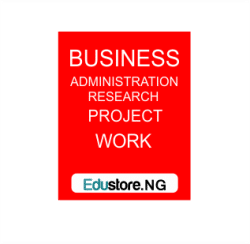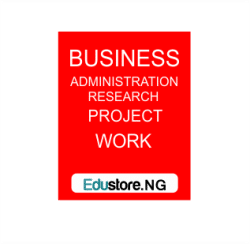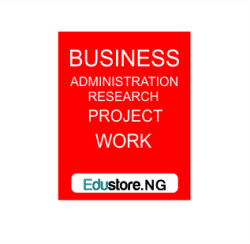CHAPTER ONIE
INTRODUCTION
1.1 BACKGROUND OF THE STUDY
Total quality management “TQM” as an organizational cultural, commitment to satisfying customer through the use of an integrated systems of tools, techniques, and training, Lawal et al (2000) TQM refers to a quest for quality that involves everyone in an organization. The use of quality management has become wide spread among organizations during the last decades. The aims of the business may differ, but the importance of customers is a matter of common interest, and the ability of organizations to adopt to new customer requirements in a global market is of vital importance for long‑term success. The aim of TQM is to do things in the first time, rather than needs to fix problems after they emerge. Quality assurance through statistical methods is a key components.
TQM has become frequent needs in term of discussion concerning quality. The national and international competitive environment to a process of constant change by the globalization of economic agents. The process of change has brought increased demands on the organizations competitiveness and the customers have gained a central role in the organization’s focus. TQM is considered to be an important management philosophy which supports the organizations in their efforts to obtain satisfied customers.
However, there exists extensive numbers of companies failed on implementation process of TQM. This is problematic phenomenon which negatively affect organizations irrespective of size in their development towards business excellence and ultimately survival in a competitive environment.
For optimal utilization of resources input in company, be it private or public, big or small, it must ensure adequate and up to date training of staff on TQM as they are the one to manipulate other inputs to boost organizational performance.
1.2 SCOPE OF THE STUDY
This research is based on how effective is total quality management in small and large scale business organizations.
It also looks into variable that enhance effective TQM. However, it will be very clear that Total Quality management is very important because it goes a long way in determining the quality and other factors that might go beyond the scope of this research study.
1.3 OBJECTIVE OF THE STUDY
This research work would help to identify those likely problems that may be faced by any small or large business Organisation and prefer likely solution for choosing the model in term of TQM that may suit their operations. It will also serve as an. eye opener to the various alternative methods of Total Quality Management, therefore reducing the total cost of production while increasing organisation profitability and customer satisfaction.
1.4 SIGNIFICANCE OF THE STUDY
Companies that subscribe to total quality management principles experience outstanding returns on their investment. Any companies that adopted TQM practice experienced on overall improvement in corporate performance. Companies that use TQM achieved better employee relations, higher productivity, greater customer satisfaction, increased market share and improved profitability.
Furthermore, any companies that embark on TQM sustained competitive advantage over other competitors, Evans and Lindsay (1996).
1.5 DEFINITION OF KEY WORDS
i. Company: A private or public owned producer of goods or services.
ii. Customer: These are the people that buy company’s product either for consumption or resale.
iii. Employee: These are human resources or workers that put their effort in an organisation in achieving set goal.
iv. Management: This is an act of getting thing done through the subordinates. However, TQM is a managed process which involved people, systems and supporting tools and techniques.
v. Organisation: This term and company are synonymously used in this study, but an organisation may mean a building and the process of grouping the activities into various stages and in a unified system.
vi. Performance: This is the activities in the organisation at large that has to do with effectiveness with profitability, sales volume, productivity, survival etc.
vii. Product: This is the physical end of an organisation that can be touched, perceived and offer for sales to generate revenue
viii. Quality: This means conformance to requirements. This definition allows us to measure quality.
ix. Total: It means that everyone in the organisation is involved in the final product or services delivered to the customer.
x. Training: This is the process of learning the skills that needs to do a job.
REFERENCES
Evans, James R. and Lindsay, Williams M. (1996), The Management and Control of Quality, 3rd Edition, St. Paul, MN; West Publishing Company. London.
Lawal, A.A.; Kio, J.; Seido, F.; Sulaimon A.H.; Adebayo, O.I. (2000) Entrepreneurship Development in Small‑Scale Business, Lagos, Labson Resource, Nigeria Limited. Australia.
Terziovski Mile and Samson Danny (1999) “The Link between Total Quality Management Practice and Organisational Performance”, International Journal of Quality & Reliability Management, Vol. 16, No. 3, pp. 226-237.
DOWNLOAD COMPLETE WORK- For Reference Only: Materials are for research, citation, and idea generation purposes and not for submission as your original final year project work.
- Avoid Plagiarism: Do not copy or submit this content as your own project. Doing so may result in academic consequences.
- Use as a Framework: This complete project research material should guide the development of your own final year project work.
- Academic Access: This platform is designed to reduce the stress of visiting school libraries by providing easy access to research materials.
- Institutional Support: Tertiary institutions encourage the review of previous academic works such as journals and theses.
- Open Education: The site is maintained through paid subscriptions to continue offering open access educational resources.






